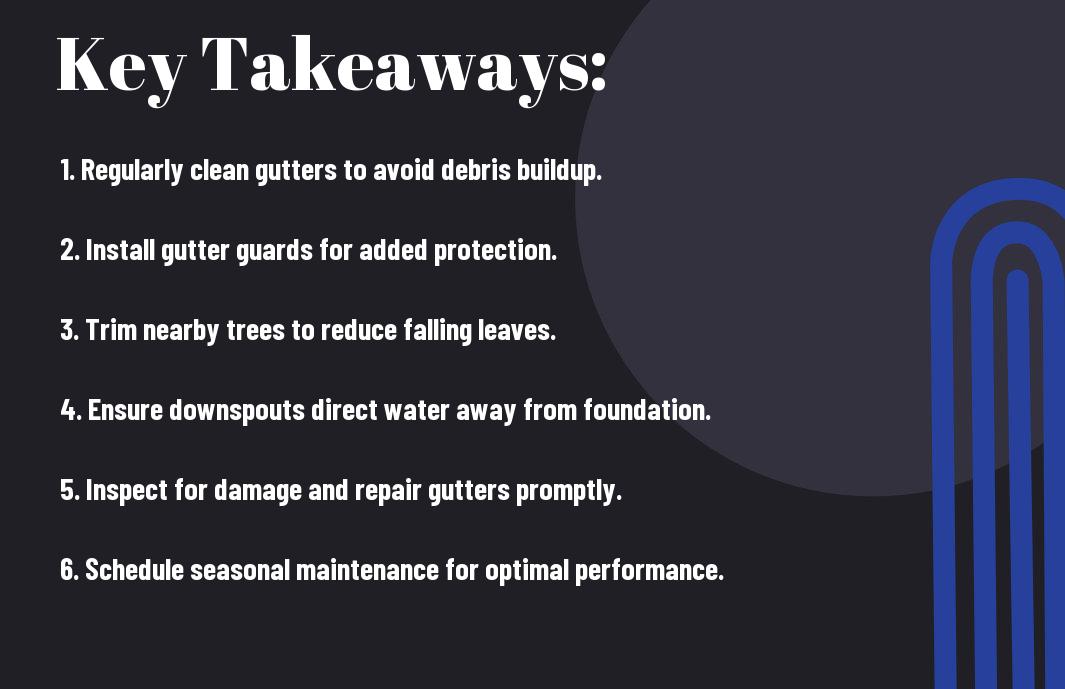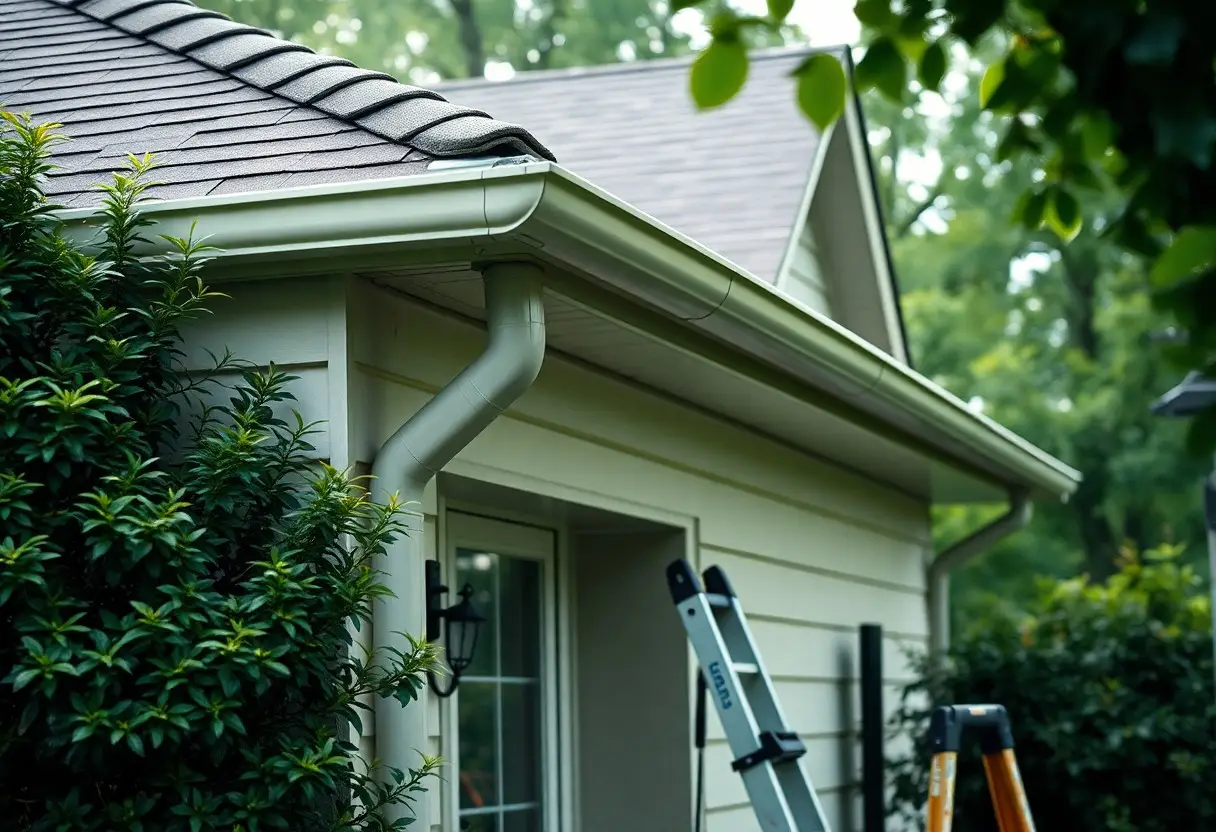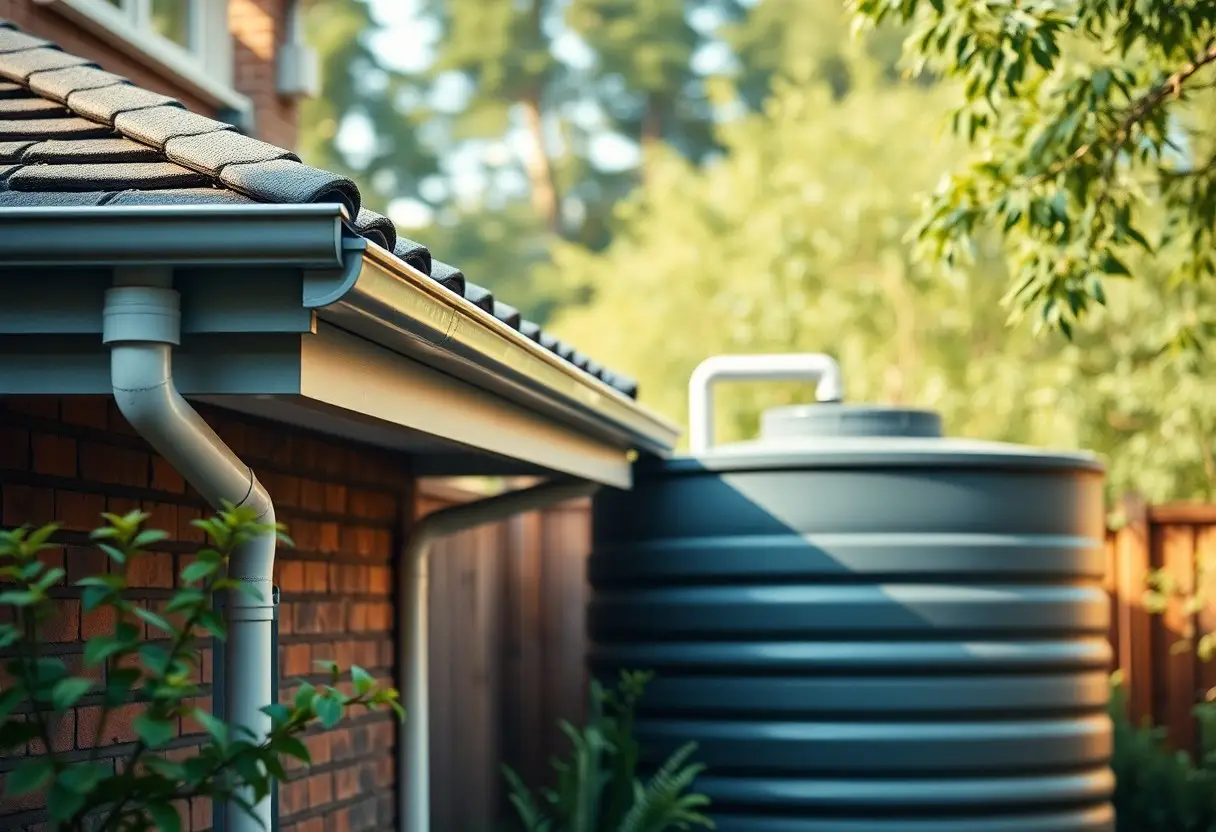Many homeowners face issues with clogged gutters, which can lead to serious problems like water damage or foundation issues. Taking proactive measures to keep your gutters clean can save you from costly repairs. In this post, you’ll discover seven simple steps that you can implement to ensure your gutters remain clear and functional. By following these guidelines, you will not only enhance your home’s longevity but also maintain its aesthetic appeal, protecting your largest investment—your home.
Key Takeaways:
- Regularly inspect and clean your gutters to remove debris, leaves, and dirt that can cause clogs.
- Install gutter guards to minimize the accumulation of leaves and other materials in your gutters.
- Ensure proper gutter alignment and downspout positioning to promote effective drainage and prevent overflow.
Understanding Gutter Clogs
A gutter clog can lead to serious issues for your home, including water damage and structural problems. When debris accumulates in your gutters, it prevents water from flowing freely and can cause overflowing, backflow, and even sagging gutters. Understanding how clogs occur and the factors that contribute to them is key to maintaining a healthy gutter system and protecting your property from potential damage.
Common Causes of Gutter Clogs
An array of factors can contribute to gutter clogs, including leaves, twigs, and other organic debris that collect in your gutters. Bird nests, pollen, and dirt can also accumulate over time, obstructing the flow of water. If your gutters are not regularly cleaned or are poorly designed, they become increasingly prone to blockage, causing rainwater to back up and increasing the risk of damage to your roof and foundation.
Signs of Clogged Gutters
Beside drainage issues, you may notice several signs indicating that your gutters are clogged. Water overflow during rainstorms, visible debris accumulation, and water stains on your home’s exterior are all indicators of potential gutter blockage. If you observe these symptoms, it’s vital to address them before they escalate into serious problems.
For instance, if your gutters overflow during a rainstorm, this can cause water to seep into your home’s foundation, leading to mold growth and structural damage. Additionally, pools of water near the foundation may lead to landscape erosion. By staying vigilant for these signs, such as sagging gutters or pest infestations, you can take proactive measures to prevent costly repairs and ensure your home remains safe and dry.

Step 1: Regular Maintenance Schedule
While maintaining your gutters may seem like a tedious task, establishing a regular maintenance schedule is necessary for preventing clogs. By dedicating time throughout the year to inspect and clean your gutters, you can effectively minimize debris buildup, ensuring that rainwater flows freely. Consistency in your schedule encourages you to stay proactive, ultimately saving you the headache of larger problems down the line.
Importance of Consistency
Beside fostering good habits, consistency in your gutter maintenance routine makes it easier to spot issues before they escalate. Regularly checking your gutters helps you to develop a keen awareness of their condition, allowing you to address minor clogs or damages promptly. Over time, this commitment will significantly lower the risk of water damage and costly repairs to your home.
Seasonal Considerations
Among the various factors that influence your maintenance schedule, the change in seasons plays a vital role. During the autumn, leaves and debris fall, necessitating more frequent checks and cleanings. In winter, ice buildup can occur, which may lead to blockages. Spring is another key time to inspect your gutters after winter storms, ensuring everything is clear for the downpours ahead. Additionally, summer storms can introduce new debris, highlighting the importance of a well-planned maintenance strategy.
Another vital aspect of seasonal considerations is the local climate and its impact on debris accumulation. In regions with heavy rainfall, gutter maintenance should ideally happen more frequently to prevent overflow. Additionally, if you live in a wooded area, the amount of leaves and twigs in your gutters can increase, requiring you to adjust your schedule accordingly. By being aware of these seasonal changes, you can take proactive steps to protect your home from potential damage caused by clogged gutters.
Step 2: Proper Gutter Installation
For effective gutter clog prevention, ensuring proper installation is key. This includes selecting high-quality materials and ensuring an appropriate fit for your home’s architecture. If your gutters are poorly installed, they can lead to water runoff issues, ultimately causing significant damage to your home. Taking the time to install your gutters correctly will not only enhance their functionality but also protect your property from long-term risks associated with water damage.
Choosing the Right Size and Type
One of the first steps in proper gutter installation is choosing the right size and type to meet your needs. Evaluate your roof size, pitch, and local rainfall patterns. Standard gutters typically range from 5 to 6 inches, but larger roofs may benefit from oversized options for improved performance. Additionally, consider materials like aluminum, vinyl, or copper, each offering different benefits in terms of durability and maintenance.
Ensuring Correct Slope and Alignment
Alignment is vital to ensure that your gutters perform effectively. They should have a slight slope (generally 1 to 2 percent) towards the downspouts to facilitate proper drainage. If your gutters are misaligned, water can pool, leading to clogs and potential overflow. Additionally, always check that your gutters are securely attached and free from any obstructions to maximize their efficiency.
In addition to regular maintenance, achieving the right slope and alignment during installation is crucial for preventing water accumulation. If your gutters aren’t angled correctly, this can create a breeding ground for debris and lead to serious backup issues. Misalignment can cause water to overflow, damaging your home’s foundation and encouraging mold growth. By investing time in proper installation, you’ll significantly reduce the risk of future clogs, ensuring a smooth flow of water away from your home.
Step 3: Install Gutter Guards
Your gutters can significantly benefit from installing gutter guards, which help to keep debris at bay and enhance water flow. Gutter guards act as a protective barrier, preventing leaves and twigs from clogging your downspouts and gutters. By taking this step, you can reduce the frequency of gutter cleaning while ensuring that rainwater is efficiently channeled away from your home’s foundation.
Types of Gutter Guards
On the market, you will come across various types of gutter guards tailored to fit different needs and preferences:
| Mesh Guards | Simply filter out debris while allowing water to flow through freely. |
| Screen Guards | Feature a finer mesh that can catch smaller particles. |
| Reverse Curve Guards | Guide rainwater into the gutter while letting debris fall to the ground. |
| Foam Inserts | Fit directly into the gutter, blocking debris while allowing water to pass through. |
| Leaf Guards | Specifically designed to prevent large leaves from obstructing your gutters. |
After selecting the right type of gutter guard, you can enjoy reduced maintenance and enhanced gutter performance.
Benefits of Gutter Guards
Benefits of installing gutter guards go beyond merely preventing clogs. These systems minimize the time and effort you need to dedicate to cleaning your gutters and protect your home from water damage. Gutter guards keep pests, such as mosquitoes and rodents, from nesting in wet debris while also enhancing your home’s overall curb appeal.
And with improved water drainage, you’ll find that your home’s foundation is less likely to suffer from erosion or flooding. Moreover, gutter guards significantly reduce the risk of ice dam formation during winter months, protecting your roof and gutters. Ultimately, investing in gutter guards offers long-term savings and peace of mind, knowing your home is safeguarded against potential water damage.
Step 4: Keep Surrounding Areas Clear
Unlike ignoring the space around your home, maintaining clear surrounding areas is imperative for effective gutter clog prevention. Trees, bushes, and debris can easily find their way into your gutters, leading to unwanted blockages. Regularly inspect your yard and remove leaves, twigs, and other organic matter that could contribute to gutter issues. This proactive approach helps you maintain a healthier drainage system and avoid costly repairs down the line.
Landscaping Considerations
By selecting appropriate landscaping plants, you can reduce debris accumulation in your gutters. Opt for vegetation that produces minimal leaf litter and avoid planting large trees near your gutters. This choice not only enhances your landscape’s appearance but also minimizes the maintenance burden on your gutter system.
Debris Management
Management of debris is imperative for keeping your gutters functioning effectively. Regularly check and clean your gutters, downspouts, and surrounding areas to ensure they remain free from blockages. Employing mesh screens can also help in preventing leaves and twigs from entering your gutters, safeguarding them against potential clogs.
In addition to regular cleaning, adopting a solid debris management routine can vastly improve your gutter maintenance strategy. By scheduling seasonal inspections and cleanings, you can identify problem areas early and address them before they become serious issues. A well-maintained gutter system not only protects your home from water damage but also enhances your property’s overall value, providing long-term benefits. Stay proactive, and your gutter systems will thank you!

Step 5: Educate Family Members
Not taking the time to educate your family members about gutter maintenance can lead to serious issues. Ensuring everyone understands the importance of keeping your gutters clear will help prevent clogs and protect your home from water damage. Engaging your family in discussions about this responsibility can foster teamwork and awareness.
Importance of Awareness
Among the many reasons to educate your family about gutter maintenance is the potential for costly repairs. When members know the signs of a clog and the significance of timely intervention, they can help safeguard your home against water damage and the hazards associated with overflowing gutters, such as mold growth and landscape erosion.
Assigning Responsibilities
Below, you can outline specific tasks related to gutter maintenance for each family member. By assigning responsibilities, you create a shared sense of ownership and accountability within your household.
With well-defined roles, you can ensure that your home’s gutter system remains in top condition. Assign tasks such as *regular inspections*, *cleaning debris*, and *reporting any issues* to different family members. This shared effort not only lightens the burden but also keeps everyone engaged and informed. Make sure to emphasize the dangers of neglecting gutter care, including potential *water damage*, *structural issues*, and *safety risks* that come from overflowing gutters. By working together, your family can effectively prevent clogs, protect your home, and maintain a safe living environment.
How Do the Steps for Gutter Clog Prevention This Fall Compare to the Complete Prevention Guide?
As leaves begin to fall, understanding the difference in strategies for gutter clog prevention becomes essential. This fall, focus on regular inspections and cleanings to fend off clogs. Comparing these steps with the complete prevention guide highlights the importance of routine maintenance and seasonal preparation for optimal drainage year-round.
Conclusion
As a reminder, by following these 7 simple steps for complete gutter clog prevention, you can significantly enhance the efficiency of your drainage system and protect your home from potential water damage. Regular maintenance, combined with strategic installation of gutter guards and routines, will ensure that your gutters function effectively throughout the year. By taking a proactive approach, you can enjoy peace of mind knowing your home is safeguarded against the elements.
FAQ
Q: What are the main causes of gutter clogs?
A: Gutter clogs often occur due to a buildup of leaves, twigs, and other debris. Overhanging branches can drop organic matter into your gutters, while roof shingles may shed mineral particles that accumulate over time. Additionally, poor gutter design or inadequate drainage systems can contribute to clogs, especially in areas with heavy rainfall.
Q: How can I effectively clean my gutters?
A: To clean your gutters effectively, start by gathering the necessary tools, such as a ladder, gloves, a scoop or trowel, and a bucket. Safely position the ladder and begin at one end of the gutter, using the scoop to remove debris. Follow up by running water through the gutter to ensure it flows freely and check downspouts for blockage. It is recommended to perform this cleaning at least twice a year, preferably in spring and fall, to prevent excessive buildup.
Q: What preventive measures can I take to avoid future clogs?
A: To prevent future clogs, consider installing gutter guards or screens that keep larger debris out while allowing water to flow through. Additionally, trimming overhanging tree branches can reduce the amount of debris that falls into the gutters. Regular maintenance checks, including cleaning and inspecting the gutters and downspouts, will help identify potential issues before they become serious problems. Properly sloping gutters toward downspouts can also facilitate better drainage and minimize clogs.


